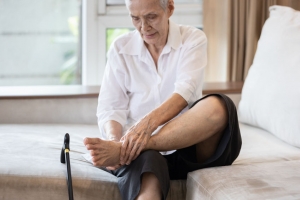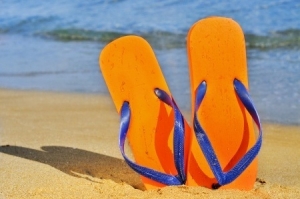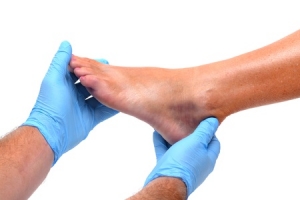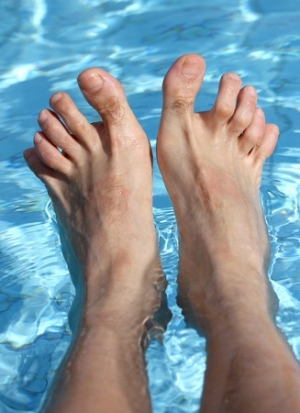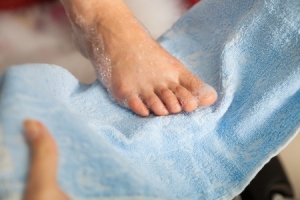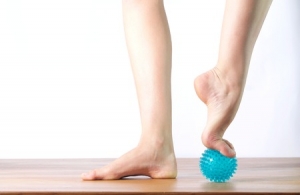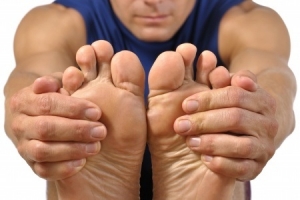Connect With Us
Blog
Displaying items by tag: hammertoe
Corns and Calluses on Your Feet
At Superior Foot & Ankle Care Center some of the problems our Los Angeles County patients bring to us most frequently are caused by repetitive friction and pressure being applied to the feet. Below are two common podiatric conditions of this type and what’s behind them.
Corns—typically corns appear on the tops and sides of the toes or between toes. They are the result of pressure from footwear or toes on toes and are often a secondary condition that develops as the result of a deformity such as a bunion, hammertoe, or claw toe. The deformity makes it difficult to fit into shoes and the constant pressure to a spot that is out of place or enlarged causes the corn to form.
Calluses—calluses are thickened patches of skin that are hard and tough. Although the problem manifests on the surface of your skin, the source is usually much deeper in the foot. Calluses are the result of long-term pressure to a specific spot, and they most often develop on weight-bearing parts of the foot like the heel, sole, ball of the foot, or big toe. Since the issue with a callus is more than skin deep, there may be inflamed nerves or bone deformity involved as well.
Treatment Options
Both corns and calluses can be treated at home by soaking them in warm, soapy water and then using a pumice stone or foot file to gently smooth and reduce them. Apply a rich moisturizer afterward to keep the skin soft. However, the best course of treatment is to consult our podiatrists, Dr. Victoria M. Foley and Dr. Constance Ornelas, to determine the root cause of your corn or callus. It’s unlikely that the problem will be resolved completely until the underlying cause of the friction or pressure is identified and treated.
If corns or calluses are causing you pain and making it difficult to find comfortable shoes, contact our Long Beach office at (562) 420-9800 for an appointment at your earliest convenience.
5 Foot Care Tips for Seniors
Did you know that the average person walks between 2.5 and 5 miles a day? At Superior Foot & Ankle Care Center we know that means our Los Angeles County senior patients have likely put quite a few miles on their feet. In honor of Older Americans Month 2021, we’d like to offer some tips for protecting podiatric health as you age.
- Listen to your feet. Foot pain, shoes that don’t seem to fit properly anymore, and fatigue in your legs or feet are all ways that your feet communicate that something isn’t right. Don’t put off seeking an evaluation of these symptoms. Contact our Long Beach office at (562) 420-9800 to schedule an appointment with our podiatrists, Victoria M. Foley and Dr. Constance Ornelas.
- Keep feet clean and dry. Wash daily with soap and water and dry thoroughly (paying particular attention to the spaces between your toes). If you tend to sweat excessively, keep an extra pair of socks with you and change when you notice your feet feel damp. This will go a long way in preventing fungal infections like athlete’s foot and toenail fungus.
- Check your feet daily. Look over your entire foot (or ask someone to do it for you) for any unusual changes. Toenail or skin discoloration, bumps, bruises and swelling may all indicate a developing foot or even systemic problem. Diseases such as diabetes, hypertension and arthritis often first manifest in the feet.
- Choose shoes wisely. Your footwear is one of the biggest predictors of podiatric health. Look for styles that have good arch support and heel and insole cushioning. Treads should be non-slip but not have rubber over the toes which can lead to tripping. Ask the podiatrist for recommendations of shoe styles if you have a deformity such as a bunion or hammertoe. Lastly, get your feet professionally measured to ensure a proper fit and always try on both shoes before purchasing.
- Reduce fall risk. Falls are the number one cause of both fatal and non-fatal injuries in seniors. Safeguard your home by installing additional stair rails and lighting. Remove throw rugs, plant stands, electrical cords that are across walking areas, and other clutter to lower your chances of falling.
Your podiatrist is your partner in making sure your feet continue to be healthy and enable you to keep on living the active life you love. If you have any questions or concerns, don’t hesitate to contact us.
Flip-Flop Fail
They’re so easy to wear—just slip them on and off you go. In flip-flops your feet feel so free, as if there’s hardly anything there and that’s the problem! There isn’t. At Superior Foot & Ankle Care Center we know many of our patients love flip-flops and wear them nearly every day but unfortunately, it’s a shoe choice that can leave your feet vulnerable to injury and result in serious foot problems. Here’s why:
Increased Risk of Injury—let’s start with the obvious: flip-flops provide very little protection for your feet. Since they are so exposed, your toes are not shielded from getting stubbed and cuts can happen when your foot slides off the shoe. In addition, because there are no sides to hold your foot in place, flip-flop wearers are more likely to sprain an ankle.
Toe Stress—think about the motion required to keep flip-flops on. Your toes are constantly gripping the front of the flip-flop. With extended use, the strain to the toes can cause tendonitis and toe deformities such as hammertoe and bunions.
The Fracture Factor—with literally no cushioning, flip-flops offer zero shock absorption as you walk. The repetitive pounding on the bottom of your foot and lack of arch support can result in stress fractures, heel pain and plantar fasciitis. You may also find that you experience pain in your ankles, knees, hip and back because of the altered gait that comes about with prolonged flip-flop use.
Finding a Better Flip-Flop
Due to the popularity of this type of footwear, some manufacturers have begun to make shoes that offer the easy style of flip-flops but with an eye to lessening the damage to your feet. If you are frequent flip-flop wearer, look for the following
- A built-up centerpiece for arch support
- Flip-flops made of leather instead of plastic or vinyl to reduce blisters
- More substance—if you can bend a flip-flop completely in half it does not have enough cushioning or support
- A back strap
If you’ve been wearing flip-flops as your go-to shoes for a long time now and are experiencing pain in your ankle, toes, heel or forefoot, make an appointment at our Long Beach office by calling: (562) 420-9800. Our podiatrists, Dr. Victoria Foley or Dr. Constance Omelas will examine your feet and make specific recommendations about shoe choices that will be the healthiest for your feet.
Protecting Yourself with PAD
Peripheral arterial disease (or PAD) often affects patients that have diabetes. At Superior Foot & Ankle Care Center we always caution these patients to take extra care with their feet due to the serious one-two punch these diseases can deliver. PAD is a disease that results in poor circulation. Good blood flow is necessary for healing. Patients with diabetes often experience neuropathy or loss of sensation in their feet and toes. This means it can be difficult to perceive pain, heat or even itchy rashes—all of which may signal a situation that would result in an open sore or wound. Add PAD to that and you could end up with an ulcer or wound on your foot that will not heal. This, in turn, can lead to a dangerous infection, and, in the worst case scenario, possible amputation.
Simple Precautions
If you have diabetes you should already be on a regular schedule of checkups with our podiatrists, Dr. Victoria Foley and Dr. Constance Omelas in order to carefully monitor your condition. The foot doctor will also look for signs of PAD. In addition to having diabetes, other factors that increase your risk for PAD include:
- Being over age 50
- Smoking
- Sedentary lifestyle
- High cholesterol
- High blood pressure
- Family or personal history of PAD
With or without PAD it’s important to avoid putting your feet at risk of injury or infections. To this end, you should:
- Avoid walking barefoot. In public places, this will reduce your risk of coming in contact with fungi and bacteria that can cause infections like athlete’s foot and fungal toenails. At home, you will be far less likely to get a cut or puncture wound on the bottom of your foot if your feet are covered.
- Wear shoes that fit properly. Shoes that are too small can cause blisters or exacerbate conditions such as hammertoe and bunions. Periodically check the insides of your shoes to make sure there are no rough spots or loose stitching to cause friction against your skin.
- Keep skin soft and supple by applying a rich moisturizer to your feet. Avoid the area between your toes, however, to prevent an excessively moist environment where fungi can breed.
- Get in the habit of checking your feet regularly for any changes or abnormalities. If you spot anything unusual, contact our Long Beach office immediately to get it checked by calling: (562) 420-9800.
Myths about Hammertoes
At Superior Foot & Ankle Care Center we often find that patients have no trouble identifying a hammertoe—its telltale downward bent at the joint makes it fairly obvious—but often that’s where the knowledge stops. Too often patients suffer for a long time with a hammertoe because they do not fully understand the condition and their treatment options. Below some common myths about hammertoes are dispelled to help patients be more informed about this condition:
MYTH: Hammertoes are caused by shoes that are too tight.
TRUTH: It’s true that improperly fitting shoes can contribute to or exacerbate the condition of hammertoe but usually a muscle/tendon imbalance predisposes the toe to bend downward. In some cases, one toe is longer than the others and pushes up against the front of the shoe. Hammertoe can also be genetic, the result of arthritis or a neurological or structural issue.
MYTH: It’s possible that over time hammertoes will get better without treatment.
TRUTH: Hammertoes are a progressive condition. Although they may progress at varying rates they will not improve and will, in fact, worsen to the point of being disabling if not treated. It’s important to have one of our podiatrists, Dr. Victoria Foley and Dr. Constance Omelas examine your hammertoe to assess how far it has progressed. The foot doctor may order x-rays to get a better look at the current state of the joint and will also want to get a complete medical history. Hammertoes should be monitored by the podiatrist.
MYTH: There’s no real treatment for hammertoes.
TRUTH: Actually there are several conservative options available to the foot doctor to help decrease pain, increase comfort and slow the progression of a hammertoe. These include: strapping or taping the toe to establish realignment, using a custom orthotic device to correct or compensate for a muscle tendon imbalance and doing stretching and other exercises to increase flexibility and strengthen supporting muscles. In addition, patients should choose shoes with low heels that have roomy toe boxes and are made of soft materials to avoid further stress to the toe and irritations such as corns, calluses, and ulcers from developing. If none of these treatments are successful or there are other deformities such as bunions in addition to the hammertoe the foot doctor may recommend surgery to correct the problem.
You have options so don’t suffer needlessly. If you have a hammertoe contact us for an appointment at our Long Beach office today by calling: 562-420-9800.
Diabetes: Making Positive Choices
At Superior Foot & Ankle Care Center we know that diabetes doesn’t have to prevent you from living a full and active life. We treat many patients with this disease and we know it can have a big impact on the health of your feet. Diabetes impedes the circulatory and immune systems increasing the likelihood of infections and decreasing the body’s ability to heal. To make matters worse, neuropathy, a condition also commonly associated with diabetes, makes it difficult to perceive sensations like pain or heat which would signal a potential wound. The good news is there’s much you can do to protect your feet. In recognition of National Diabetes Awareness Month we’d like to focus on some particularly important areas:
Foot Care—Your feet can be both a recipient and an early warning system with regard to problems with diabetes. For that reason, inspecting your feet on a daily basis is essential. Changes in skin or nails, lumps, swelling, bruises, redness, blisters can all signal a potential problem developing. It’s critical that one of our foot doctors, Dr. Victoria Foley or Dr. Constance Omelas be informed of any unusual changes immediately. A good care regimen can also help decrease the risk of foot problems in diabetic patients. Wash feet with a mild soap in warm—not hot—water and dry completely, especially between your toes.
Shoes—Although well-made, properly fitted shoes can help reduce the risk of foot disorders in all patients, those with diabetes have specific concerns to address. Look for shoes that are well cushioned to reduce impact to the soles of your feet. Shoes should be laced and fit snugly (but not tight) to provide stability and limit side to side movement of the foot. If you have a toe deformity such as a bunion or hammertoe, special padding may be prescribed to prevent rubbing and friction which could lead to a corn or callus. Be sure the front of the shoe is roomy to prevent toes from being squeezed together.
Keep Feet Dry—Damp feet can lead to a fungal infection. If you tend to sweat profusely you can use a foot powder or even antiperspirant on the soles of your feet to reduce wetness. Change socks whenever you notice they are damp.
Healthy Lifestyle—Follow your doctor’s instructions for controlling your diabetes. Don’t smoke (it will further impede your circulation). Eat a healthy diet that is high in protein, vegetables and whole grains and limits saturated and trans fats and sugars. Exercise regularly for good joint health and weight control.
If you have additional questions about foot health and diabetes, contact our Long Beach office by calling: 562-420-9800.
5 Exercises for Your Toes
Are you taking your toes for granted? At Superior Foot & Ankle Care Center we find many patients do. Your toes help you maintain your balance and enable you to push off when your walk. If toes hurt or become deformed it can lead to serious disability. Below are 5 simple exercises that will keep toes flexible and help ease foot pain for conditions such as hammertoe, bunions, toe cramps, plantar fasciitis and more:
- Big Toe Pulls: In a seated position, place feet next to each other and place a thick rubber band around the two big toes. Pull them apart, moving each toe toward the little toes. Hold the position for 5 seconds. Repeat 10 times.
- Put a Cork in It: Take small corks and place them between each of your toes on one foot. Squeeze toes together and hold for 5 seconds. Do 10 repetitions with each foot.
- Marble Pick-Up: Sitting in a chair spread 20 marbles on the floor in front of you. Pick up each marble, one at a time, with the toes of one of your feet and deposit them in a bowl. After you pick up all 20 marbles, spread them back on the floor and pick up with the other foot.
- Towel Curls: While sitting, spread towel on the floor in front of you. Using the toes on both your feet pick up the towel by curling it toward you. Repeat 5 times. Relax toes and rest a few seconds between repetitions.
- Golf Ball Massage: When you’ve finished the above exercises, reward your feet by place a golf ball on the floor and rolling it under each forefoot for 2-3 minutes.
Of course toe exercises are not a cure or solution to chronic foot pain. If you are experiencing discomfort in your feet or toes, make an appointment at our Long Beach office so that our foot doctors, Dr. Victoria Foley and Dr. Constance Omelas can examine your feet and arrive at a correct diagnosis and appropriate treatment for your foot or toe pain. Contact us by calling: 562-420-9800.
Questions about Hammertoe
One thing just about everyone knows about hammertoe is how to recognize it. The telltale downward bend of the toe in the shape of a hammer make it an obvious deformity to spot. At Superior Foot & Ankle Care Center we have found that beyond its appearance, many patients don’t have all the facts about this condition. Below are some common questions and answers about hammertoe:
- What’s the cause of hammertoe? This condition is often the result of a muscle imbalance but can be exacerbated by wearing shoes that don’t fit well or styles that have narrow toe boxes or force the foot into the front of the shoe, like high heels. Other possible factors in a hammertoe forming are genetics and arthritis.
- Which toes are affected? The second, third and fourth toe are usually the ones affected by this condition.
- Is all the pain and discomfort in the joint? No. While the abnormal position of the toe does cause inflammation, pain and discomfort, corns often form on the top of the toe due to the friction of rubbing on shoes and calluses may develop in the ball of the foot from the excessive pressure caused by the bent toe.
- How are hammertoes treated? Treatment of hammertoe is multi-dimensional. Our podiatrists, Dr. Victoria Foley and Dr. Constance Omelas will want to perform a complete examination of your toes and feet, which may include x-rays. If you are experiencing a fair amount of pain, anti-inflammatory medications and cortisone injections may be recommended to reduce the pain and inflammation. To correct the hammertoe, custom orthotics and/or splinting and taping the affected toe may be an option. Physical therapy and exercise can help stretch and strengthen the toe.
- Will hammertoe go away without treatment? Hammertoe is a progressive condition. In fact, if left untreated, the toe will become increasingly rigid in its bent position and eventually will only be correctable with surgery.
If you have noticed any signs of hammertoe, the sooner you get it evaluated the less intense and more successful non-surgical treatment is likely to be. Contact our Long Beach office for an appointment by calling: 562-420-9800.
Archives
Categories
- Featured (164)
- Blog (177)
- Ankle Care (6)
- Ankle Condition (2)
- Ankle Pain (0)
- Appointment Tips (2)
- Arch Pain (1)
- Arthritis (10)
- Athlete's Foot (6)
- Blister (1)
- Bunions (7)
- Calluses (1)
- Child Care (2)
- Circulation (1)
- Common Foot Conditions (4)
- Common Foot Problems (3)
- Corns (0)
- Custom Orthotics (1)
- Diabetes (10)
- Diabetic Foot Care (3)
- Diabetic Footwear (1)
- Edema (1)
- Exercise (4)
- Fall Prevention (1)
- Fitness (1)
- Flat Feet (2)
- Foot Care (19)
- Foot Care Safety Tips (3)
- Foot Care Tips (20)
- Foot Conditions (12)
- Foot Facts (3)
- Foot Health (6)
- Foot Odor (1)
- Foot Pain (5)
- Foot Problems (2)
- Foot Safety (1)
- Foot Surgery Tips (2)
- Foot Warts (2)
- Foot Wear (2)
- Fractures (1)
- Fungal Infection (2)
- General Health (0)
- Gout (5)
- Gout Treatment (0)
- Hammertoe (1)
- Health Tips (46)
- Heart Health (1)
- Heel Pain (0)
- Heel Spurs (0)
- Ingrown Toenails (4)
- Interesting Facts (2)
- Joint Pain (2)
- Leg Conditions (2)
- Leg Condtions (0)
- Men's Foot Health (1)
- Metatarsals (0)
- Nail Fungus (2)
- Neuropathy (1)
- Nutrition (2)
- Obesity (2)
- Osteoporosis (1)
- Pain Relief (5)
- Patient Communications (1)
- Pediatric Foot Conditions (5)
- Pediatric Foot Pain (2)
- Pedicure (1)
- Peripheral Arterial Disease (1)
- Plantar Fasciitis (2)
- Podiatrist Appointment (0)
- Pregnancy Feet (3)
- Proper Shoes (2)
- Senior Foot Care (7)
- Shoe Fit (1)
- Skin Cancer (3)
- Sports Injuries (2)
- Spring Foot Health (1)
- Summer Foot Health (2)
- Toe Pain (4)
- Uncategorized (5)
- Varicose Veins (2)
- Walking (1)
- Women Foot Health (3)
- Youth Sports (2)

